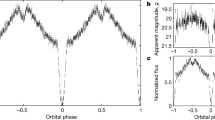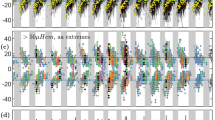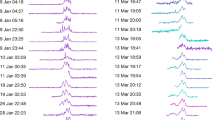Abstract
On June 30, 1973, Concorde 001 intercepted the path of a solar eclipse over North Africa, Flying at Mach 2.05 the aircraft provided seven observers from France, Britain and the United States with 74 min of totality bounded by extended second (7 min) and third (12 min) contacts. The former permitted searches for time variations of much longer period than previously possible and the latter provided an opportunity for chromospheric observations of improved height resolution. The altitude, which varied between 16,200 and 17,700 m, freed the observations from the usual weather problems and greatly reduced atmospheric absorption and sky noise in regions of the infrared.
This is a preview of subscription content, access via your institution
Access options
Subscribe to this journal
Receive 51 print issues and online access
$199.00 per year
only $3.90 per issue
Buy this article
- Purchase on Springer Link
- Instant access to full article PDF
Prices may be subject to local taxes which are calculated during checkout
Similar content being viewed by others
Author information
Authors and Affiliations
Rights and permissions
About this article
Cite this article
BECKMAN, J., BEGOT, J., CHARVIN, P. et al. Eclipse Flight of Concorde 001. Nature 246, 72–74 (1973). https://doi.org/10.1038/246072a0
Received:
Issue Date:
DOI: https://doi.org/10.1038/246072a0
This article is cited by
-
Visible Emission Line Spectroscopy of the Solar Corona During the 2019 Total Solar Eclipse
Solar Physics (2023)
-
Chasing White-Light Flares
Solar Physics (2016)
-
Solar eclipses as an astrophysical laboratory
Nature (2009)
-
Submillimetre brightness spike at the solar limb
Nature (1975)
-
Differential activation by cell fusion of Epstein-Barr viral and type-C viral genomes in non-productive human lymphoid cells
Archives of Virology (1975)
Comments
By submitting a comment you agree to abide by our Terms and Community Guidelines. If you find something abusive or that does not comply with our terms or guidelines please flag it as inappropriate.



